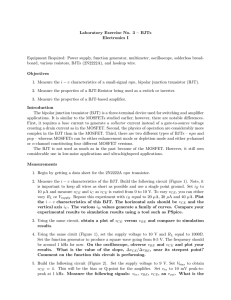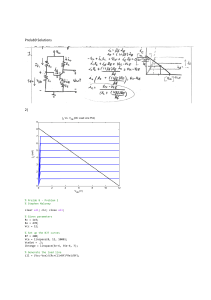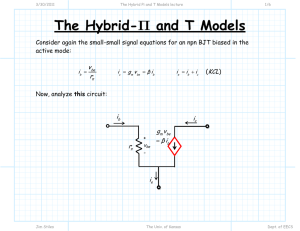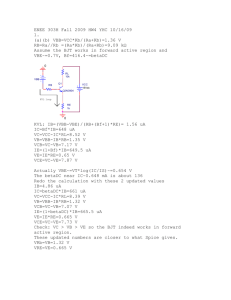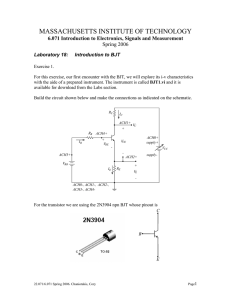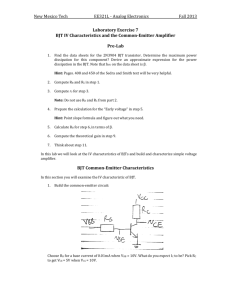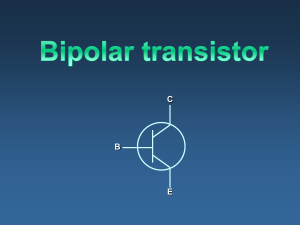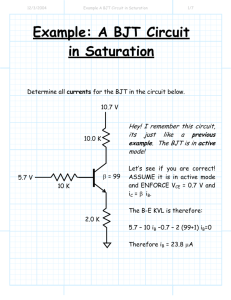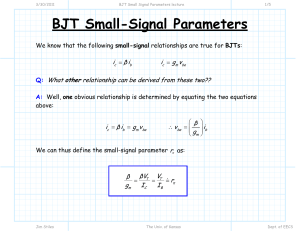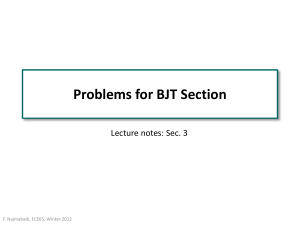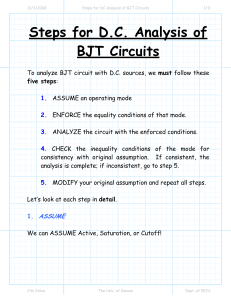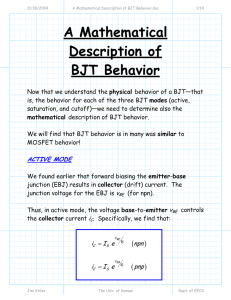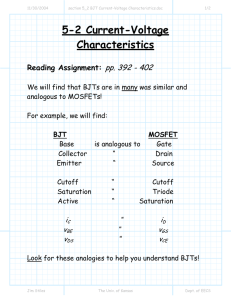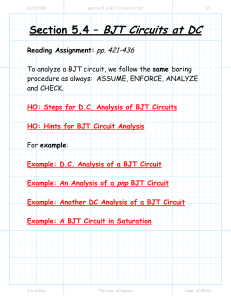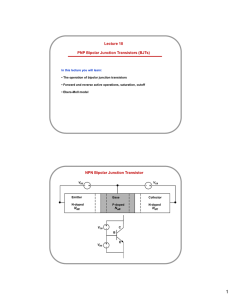Example: DC Analysis of a BJT Circuit
advertisement
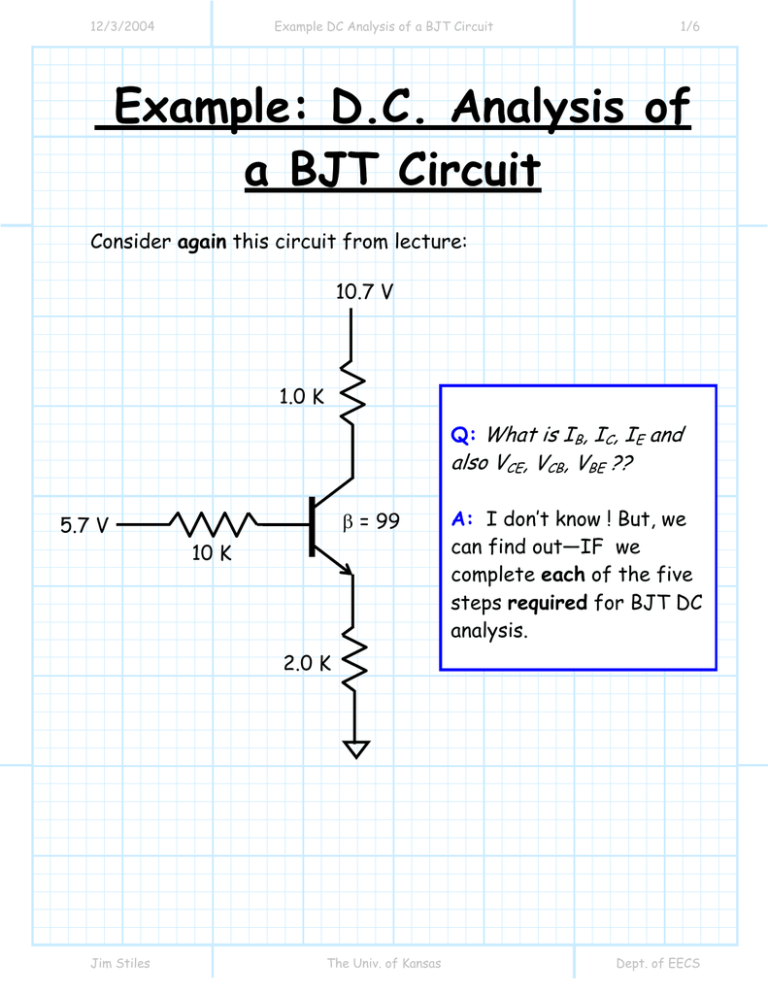
12/3/2004 Example DC Analysis of a BJT Circuit 1/6 Example: D.C. Analysis of a BJT Circuit Consider again this circuit from lecture: 10.7 V 1.0 K Q: What is IB, IC, IE and also VCE, VCB, VBE ?? β = 99 5.7 V 10 K A: I don’t know ! But, we can find out—IF we complete each of the five steps required for BJT DC analysis. 2.0 K Jim Stiles The Univ. of Kansas Dept. of EECS 12/3/2004 Example DC Analysis of a BJT Circuit 2/6 Step 1 – ASSUME an operating mode. Let’s ASSUME the BJT is in the ACTIVE region ! Remember, this is just a guess; we have no way of knowing for sure what mode the BJT is in at this point. Step 2 - ENFORCE the conditions of the assumed mode. For active region, these are: VBE = 0.7 V and IC = β IB = 99 IB Step 3 – ANALYZE the circuit. This is the BIG step ! Q: Where do we even start ? A: Recall what the hint sheet says: “Write KVL equations for the base-emitter “leg” I think we should try that ! Jim Stiles The Univ. of Kansas Dept. of EECS 12/3/2004 Example DC Analysis of a BJT Circuit 3/6 10.7 V The base-emitter KVL equation is: 5.7 − 10 IB −VBE − 2 IE = 0 1.0 K This is the circuit equation; note that it contains 3 unknowns (iB, iC, and VBE). IB 5.7 V 10 K + Now let’s add the relevant device equations: β = 99 VBE - 2.0 K IE VBE = 0.7 V IE = ( β + 1) IB = 100 IB Look what we now have ! 3 equations and 3 unknowns (this is a good thing). Inserting the device equations into the B-E KVL: 5.7 - 10 IB - 0.7 - 2 (99 + 1) IB = 0 Therefore: 5.0 – 210 IB =0 Jim Stiles 1 equations and 1 unknown ! The Univ. of Kansas Dept. of EECS 12/3/2004 Example DC Analysis of a BJT Circuit Solving, we get: IB = 4/6 5.0 = 23.8 µA 210 Q: Whew ! That was an awful lot of work for just one current, and we still have two more currents to find. A: No we don’t ! Since we determined one current for a BJT in active mode, we’ve determined them all ! I.E., IC = β IB = 2.356 mA IE = ( β + 1) IB = 2.380 mA (Note that IC + IB = IE) Now for the voltages ! Since we know the currents, we can find the voltages using KVL. For example, let’s determine VCE. We can do this either by finding the voltage at the collector VC (wrt ground) and voltage at the emitter VE (wrt ground) and then subtracting (VCE = VC –VE). OR, we can determine VCE directly from the C-E KVL equation. Jim Stiles The Univ. of Kansas Dept. of EECS 12/3/2004 Example DC Analysis of a BJT Circuit 5/6 10.7 V VC = 10.7 − IC (1 ) = 10.7 − 2.36 = 8.34 V VC and: VE = 0 + IE (2 ) 5.7 V + VCE 10 K = 0 + 4.76 = 4.76 iC 1.0 K - VE V 2.0 K Therefore, iE VCE = VC – VE = 3.58 V Note we could have likewise written the C-E KVL: 10.7 − IC (1 ) −VCE − IE (2 ) = 0 Therefore, VCE = 10.7 − IC (1 ) − IE (2 ) = 3.58 V Q: So, I guess we write the collector-base KVL to find VCB ? A: You can, but a wiser choice would be to simply apply KVL to the transistor ! Jim Stiles The Univ. of Kansas Dept. of EECS 12/3/2004 Example DC Analysis of a BJT Circuit 6/6 I.E., VCE = VCB + VBE !! Therefore VCB = VCE – VBE = 2.88 V Q: This has been hard. I’m glad we’re finished ! A: Finished ! We still have 2 more steps to go! Step 4 – CHECK to see if your results are consistent with your assumption. For active mode: VCE = 3.58 V > 0.7 V IB = 23.8 µΑ > 0.0 Are assumption was correct, and therefore so are our answers ! No need to go on to Step 5 . Jim Stiles The Univ. of Kansas Dept. of EECS
